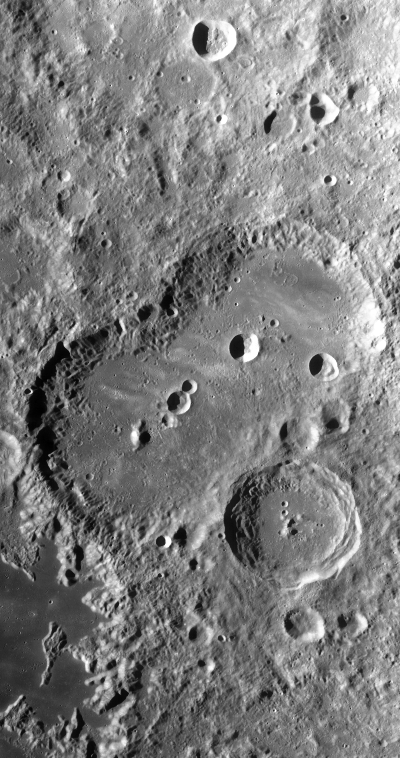The texture of ejecta thrown from Van de Graaff Crater along the northern rim, seen from a low Sun angle in the NAC image (incidence angle = 72°). This subset of the NAC image M115177455R shows a field of view of roughly 1 km. LRO orbit 2107, December 11, 2009; alt. 62.75, res. 0.98 m/p [NASA/GSFC/Arizona State University].
Sarah Braden
LROC News System
Van de Graaff crater is located on the farside of the Moon south of Aitken crater, at about latitude -27.9, longitude 172.8. Two merged craters make up the formation known as Van de Graaff crater, named after the American physicist.
Unlike other merged craters on the Moon, there is no rim separating the two "sections" of the crater. A relatively strong magnetic field was detected near this crater by the Apollo 15 subsatellite magnetometer. This discovery was unusual for the lunar surface because the Moon does not currently have a global magnetic field like the Earth does. Also, Van de Graaff and the surrounding area also have slightly higher concentrations of thorium, a radioactive metal. Are the two observations related? To find out more about Van de Graaff crater, read our Apollo Image of the Week post.
Unlike other merged craters on the Moon, there is no rim separating the two "sections" of the crater. A relatively strong magnetic field was detected near this crater by the Apollo 15 subsatellite magnetometer. This discovery was unusual for the lunar surface because the Moon does not currently have a global magnetic field like the Earth does. Also, Van de Graaff and the surrounding area also have slightly higher concentrations of thorium, a radioactive metal. Are the two observations related? To find out more about Van de Graaff crater, read our Apollo Image of the Week post.
Early LRO laser altimetry (LOLA) map of the Moon's far side show the 20 kilometer variance from mean global elevation, and the dominant 4 billion-old South Pole-Aitken basin. Van de Graaff, integral to the more ancient crater's rim, is indicated by an arrow [NASA/GSFC].
Van de Graaff crater. Mosaic of 18 LROC Wide Angle Camera passes, January 21, 2010; LRO orbits 2626 - 2634, res. averages 76 meters. "Look at the crater walls to see the unique grooved texture." (Closer view HERE. Image assembled with LROC_WAC_Image_Previewer Mosaic stitched with Microsoft ICE) [NASA/GSFC/Arizona State University].
Browse the full-resolution NAC image in our LROC Image Gallery!
(LOLA close-up of Van de Graaff, May 8, 2010)




No comments:
Post a Comment